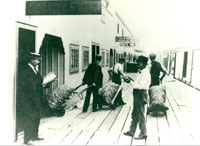
Bagged oysters catching the train to Philadelphia
If Detroit was and is the “motor city,” then perhaps Bivalve, New Jersey was the Oyster Capital of the World. By the late 1880s, 90 railcars full of oysters were shipped from Bivalve every week. Oysters were once the largest fishery product in the United States and Bivalve was its center. This weekend Bayshore Discovery Project will celebrate the history and heritage of Bivalve on the dock and in the sheds where the oyster industry once thrived.
Storytelling at Bayshore Discovery Project will bring Oyster Sheds to Life
The oyster shipping sheds in Bivalve, a port once bustling with sailing ships, baskets overflowing with oysters, and lines of shuckers, will come back to life on Saturday, April 30 from 2-4 PM. when people who once worked in the sheds will relive their experiences in the heyday of oystering. A grant from the NJ Historical Commission is funding the project, Bringing Bivalve to Life, which will include weaving the oral histories into the fabric of the Delaware Bay Museum to showcase the history and culture of the Delaware Bay oystering community. The storytelling will take place in one of the sheds on the Maurice River at 2800 High Street in Bivalve.
People who have recollections of working in the oyster sheds in Bivalve, or who had family members who did, or who lived in the area and have stories to tell about those days are encouraged to attend the event and share their stories. They may also bring photos or other artifacts to illustrate their stories. The session will be recorded for use as part of the living history exhibit which is being developed to preserve this fascinating time.
The sheds were originally built in 1904 and have been in continuous use since then. They have witnessed the ebb and flow of the oyster industry and, after the discovery of the MSX protozoan in the bay in the 1950’s, many of them changed use or gradually deteriorated. Bayshore Discovery Project started using seven of the original thirty sheds in 1996 as the homeport for the restored 1928 oyster schooner, AJ MEERWALD. Since then BDP’s been planning, raising funds and restoring the Sheds and Wharves to tell the story of the oyster industry in Port Norris and to house the Delaware Bay Museum & Folklife Center. Close to $5 million has been invested in the acquisition, stabilization and restoration to date, including funding from sources including the NJHT, NJ DOT, CCIA, NJHC, Port Norris Rotary, in kind donations, and others.
In addition to the storytellers, scholars from across the country who are studying the oyster industry and the history of this area, will be present. They will be in Bivalve to attend a working session the day before on the role of African Americans in the Maurice River Cove oyster industry. It will be an excellent opportunity for them to hear the history they are studying right from the mouths of actual participants.
All are welcome to attend the event on Saturday, April 30, from 2:00 to 4:00 PM. Refreshments will be served. Please contact Janis at the Bayshore Discovery Project at 856-785-2060 X108 if you are able to share your recollections or your artifacts and pictures.
About Bayshore Discovery Project
Bayshore Discovery Project is a non-profit grassroots organization whose mission is to motivate people to take care of the history, the culture and the environment of New Jersey’s Bayshore region through education, preservation and example. BDP operates the authentically restored 1928 oyster schooner A.J. Meerwald, New Jersey’s official Tall Ship, as a hands-on sailing classroom throughout the region; and offers shorebased educational programs and events at her home port of Bivalve, NJ, on the scenic Maurice River in Cumberland County.
Laura S. Johnson
Director of Development and Marketing
856-785-2060 x 102
ljohnson@bayshorediscovery.org

Crisfield, Md. might want to have a word about the oyster title. For several decades following the Civil War, Crisfield was known as the “Seafood Capital of the World” due to the volume of crabs, fish and oysters shipped from there via a branch of the Pennsylvania Railroad. It wasn’t until the decline of the Chesapeake oyster fishery in the 1920’s that Crisfieldlost its pre-eminence.
Seeking information about a tugboat company in or near Port Norris/Maurice River NJ in 1800’s run by Capt Joseph Heathcote